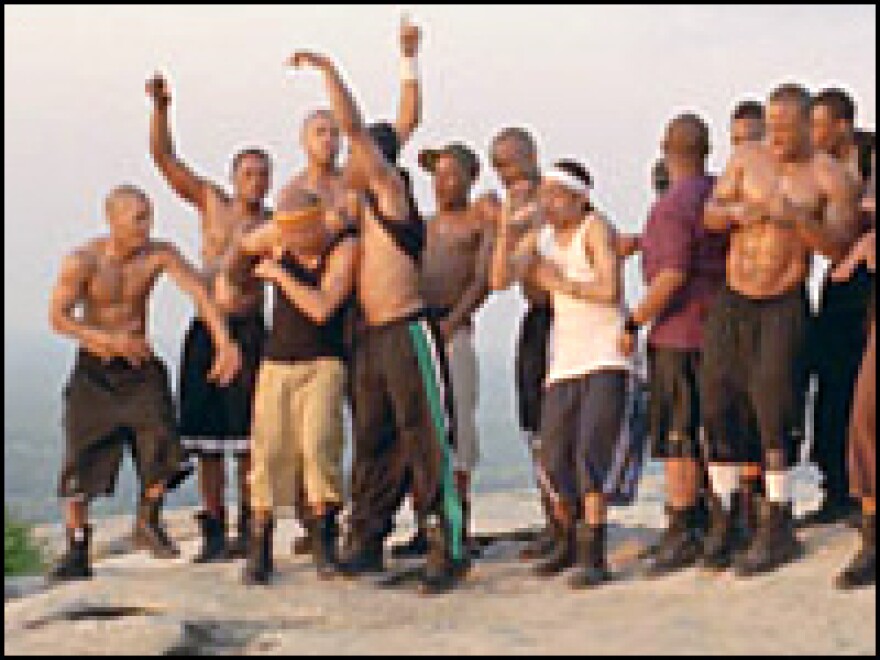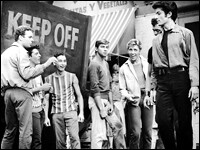Truth matters. Community matters. Your support makes both possible. LAist is one of the few places where news remains independent and free from political and corporate influence. Stand up for truth and for LAist. Make your year-end tax-deductible gift now.
Go Tough. Go Dance. Go 'Stomp the Yard'


If you want to see some dancing, you might check out the new movie Stomp the Yard.
As the movie starts, some very scary-looking guys are hurling themselves at each other in a nightclub. Their moves are aggressive, threatening, ferocious, and always stop just short of the glowering guys they're aimed at. It turns out it's a competition.
Now watching these young men dancing — and especially after one of them is killed a few moments later in a rumble — I couldn't help thinking of some other gang members dancing on screen a half-century ago. They called themselves Jets and Sharks, and their music was also percussive, but in a jazzy, symphonic way.
Though the gang members in West Side Story now look sweetly clean-cut, back then they seemed pretty tough — far tougher than, say, Fred Astaire.
"Tough guys don't dance," claimed Norman Mailer in a book title, but every generation in Hollywood wants to at least let them try. The trick is finding a reason. In the 1940s, studios did it through casting, taking machine-gun-toting Jimmy Cagney and turning him into machine-gun-tapping George M. Cohan.
Of course, in Yankee Doodle Dandy, Cagney wasn't actually playing a tough guy, and if he'd done it a few more times, his gangster credentials would have lapsed. Happily, once the ice was broken, Hollywood had no problem just letting gangsters dance as gangsters, in Guys and Dolls, for instance.
Everyone danced in the movies in the 1950s, so tough guys didn't have to make excuses. There were dancing backwoodsmen in Seven Brides for Seven Brothers, dancing convicts in Jailhouse Rock, even a dancing Asian tyrant in The King and I.
After movie musicals went out of fashion in the 1960s, producers had to come up with new reasons for their macho stars to stomp. They got pretty clever about it, turning dance into a competitive sport in Saturday Night Fever, with John Travolta working the disco the way Rocky worked the ring, and setting rebellious teenagers to defying puritanical town fathers in Footloose.
But after Michael Jackson's music video for "Beat It" pushed this notion about as far as it could go, the variations got pretty lame. At which point Hollywood ceded the dance floor to Hong Kong for a bit, as martial arts movies got more and more "choreographed."
Eventually folks like Jackie Chan weren't so much involved in combat as in aerial ballets, flying on wires and tiptoeing across treetops, and this form, too, seemed to be running its course.
But it had added something to the mix — something that ballet companies always push in their advertising — muscles on display. The Footloose generation's skinny teen rebels had been replaced by shirtless, macho fighters who looked dangerous.
And that aesthetic also drives the "hotshot-versus-the-group" movies that have come along in the last couple of years: Drumline, about a show-boating recruit to a marching band, and now Stomp the Yard, about a cocky young stepper who brings urban moves to a form he finds too tame.
The plots may be straight out of those college musicals that used to star June Allyson and Peter Lawford, but they sure look different. Shot in flash-cut, music-video-style, with lots of editing tricks, the choreographed challenges and insults look ferocious.
And why shouldn't they? Hollywood has been choreographing violence since Jimmy Cagney was dying in bullet ballets. Car chases, boxing matches, armies charging down hillsides, starships hurtling through space. Tough guys do dance — they've always danced with props — as long as it's "dirty" dancing. It's just cleaner when it's just with attitude.
Copyright 2022 NPR. To see more, visit https://www.npr.org. 9(MDA1OTI3MjQ5MDEyODUwMTE2MzM1YzNmZA004))








